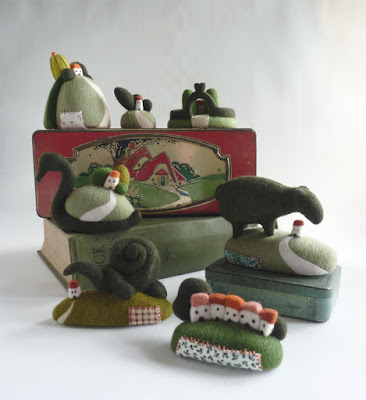This summer I have found myself making miniature landscapes and oddly, they have become a form of self portrait. Not that I am a small green hump with vegetation growing on top, but the tiny houses often appear difficult to get to, with minuscule windows implying a shy or sometimes alarmed expression.
The winding paths are one of my favourite motifs. You would have to walk up them to get to the house - and would there be anyone at home when you got there? Or are the occupants at home but not available to visitors?
I think, judging from feedback on my Facebook page and Instagram feed, that perception is everything with these pieces. The majority take them at face value; they are what they are. Sometimes people are a little alarmed at the proportionally 'giant' topiary figures. Others find them comforting. As for myself - I like the ambiguity.
'Creeper Cottage' is a case in point. The looming, topiary snail, could be seen as a threat to the house...or a gentle guardian.
I have also been adding extra surface elements, such as patches, as visual puns. The patch on the front of 'Thimble Row' is deliberately clumsy, with over sized stitches and using a thick thread, as if a child had attempted their first mending project. I think the needle must have frightened the cottages, as they are leaning back and seem somewhat shocked.
'Halfpenny Hill' is similarly 'repaired'. In an actual garden, a bare grassy lawn area is re-seeded. Here, two very small visibly stitched fragments of cloth add interest to the plain hummock. One is hidden away at the back. In life, we mend old clothes and much loved toys. In these worlds, the landscape is similarly refurbished.
'Swan Haven' is one of my more fanciful pieces; the topiary swan can never swim, but it carries an entire dwelling within a garden, as if it were a bizarre form of static barge.
The first garden I created earlier this year was the most secretive and difficult to photograph. This is entirely deliberate, as it is intended for the eventual owner to enjoy from a certain angle. My favourite view is simply head on, as if I were about to brave the long, straight path which leads to the tall, silent manor - protected (or guarded) by twin trees. Someone inside definitely knows you are coming.
'Shepherd's Cottage' is another patched and darned affair, with the sheep 'shepherding' the house - or possibly about to nibble it.
Many years ago, when I was an art student , I was taught that a good sculpture has points of interest from all views, so I delight in putting the darns in the least likely of places, where they will not at first be noticed.
The final landscape is the tiniest of all, designed to fit into a ring box.
Behind the rather melancholy looking house, is a neat, incy-wincy darn in an unlikely shade of pink. This diminutive piece of felted real estate is now on a long journey to a new home, where I hope the owner will enjoy this snippet of 'the artist disguised as a house'.





















































